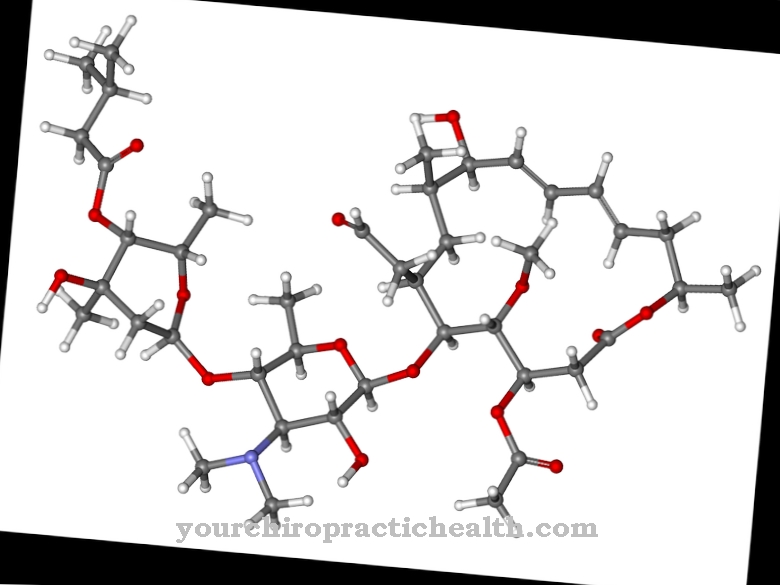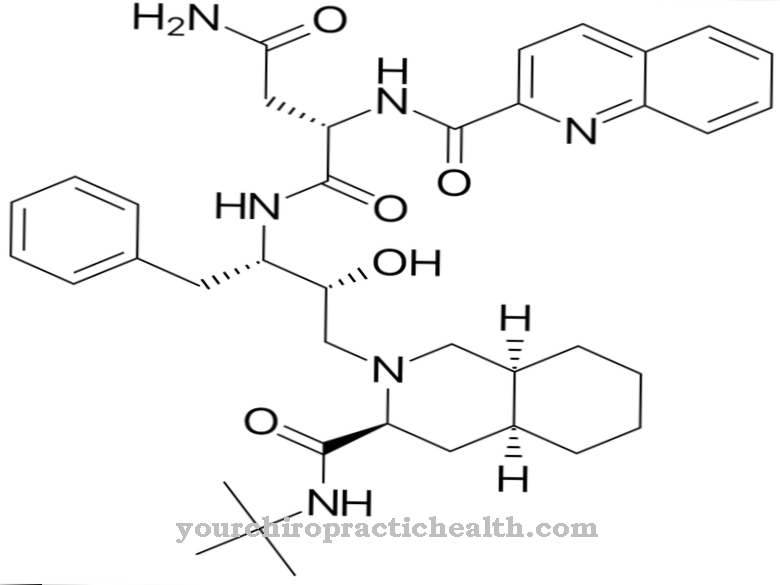Fludarabine is a cytostatic agent that is used to treat malignant diseases. For this it is administered intravenously as an infusion.
What is fludarabine?

Fludarabine, too Fludara or Fludarabine-5-dihydrogen phosphate called, is a drug from the group of purine analogues. The substance is a so-called fluorinated nucleotide analog of vidarabine. Nucleotide analogs have structural and / or functional similarities to nucleotides. Nucleotides are the basic building blocks of deoxyribonucleic acid (DNA) and ribonucleic acid (RNA). Purines are also important building blocks of nucleic acids.
In contrast to most nucleotides, fludarabine does not contain β-D-ribofuranose, but rather β-D-arabinofuranose. In addition, fluorine replaces the adenine in the 2-position.
Fludarabine is mainly used to treat low-grade non-Hodgkin lymphomas. It is also used to treat acute leukemia. Chronic lymphocytic leukemia (CLL) is also treated with fludarabine.
Pharmacological effect
Fludarabine is given intravenously. The medicinal substance reaches the cells via the bloodstream. Fludarabine becomes an active metabolite in the cells. A metabolite is an intermediate product in a biochemical metabolic pathway. The metabolite in this case is called fludarabine-ATP.
The conversion takes place through phosphorylation. In phosphorylation, a phosphate group is attached to an organic molecule. This creates a phosphor protein. Fludarabine-ATP is actually the most effective form of fludarabine. The drug interferes with DNA synthesis and inhibits ribonucleotide reductase. This enzyme forms the last link in the synthesis of the DNA building blocks. Without ribonucleotide reductase, the organism cannot produce any DNA building blocks. Whenever a cell divides or needs to repair DNA damage, it is dependent on ribonucleotide reductase.
Modifications in many cancer cells increase the rate of turnover of ribonucleotide reductase. This allows them to share faster. The fludarabine starts at this point. Due to the ribonucleotide reductase, the cells can divide more slowly or not at all. Since cancer cells usually divide very often, they are particularly affected by the effects of the drug.
Fludarabine not only inhibits ribonucleotide reductase, but also DNA polymerase. Just like ribonucleotide reductase, DNA polymerase is an enzyme. It catalyzes DNA synthesis from deoxyribonucleotides and thus plays an important role in the replication of DNA. If the DNA polymerase is inhibited, the genetic information can no longer be copied correctly. The fludarabine nucleotide is also incorporated into the DNA of the affected cell. This leads to apoptosis of the cell. Apoptosis is also known as programmed cell death. By damaging the genetic makeup, the cell triggers its own death and perishes.
Medical application & use
Fludarabine is used to treat low-grade non-Hodgkin's lymphomas. 'Non-Hodgkin lymphoma' is a collective term for all malignant diseases of the lymphatic system with the exception of Hodgkin's disease. Non-painful enlargements of the lymph nodes are just as typical of the disease as the tendency and susceptibility to infection. Those affected may also suffer from fever, night sweats, weight loss and fatigue.
Fludarabine is also used to treat acute leukemia. Leukemia is also known colloquially as blood cancer. These are malignant diseases of the blood-forming or lymphatic system. In a broader sense, leukemia can be classified as cancer. Acute myeloid leukemia (AML) and acute lymphatic leukemia (ALL) are acute leukemias. Both are treated with fludarabine.
In the case of chronic leukemia, a distinction can also be made between a myeloid and a lymphatic variant. Fludarabine is only used in the treatment of chronic lymphocytic leukemia. CLL is a low-grade, leukemic non-Hodgkin lymphoma of the B cells. It is the most common form of leukemia in the western world.
Risks & side effects
The main side effect of fludarabine is marked myelosuppression. Myelosuppression is a bone marrow inhibition. Blood formation stops due to the depression of the bone marrow. This leads to a lack of red blood cells (erythrocytes), white blood cells (leukocytes) and blood platelets (thrombocytes) in the organism.
The lack of red blood cells leads to anemia. This manifests itself in susceptibility to infection, fatigue and hair loss. The lack of white blood cells, leukopenia, also leads to a high susceptibility to infections. Thrombocytopenia, the lack of platelets, leads to an increased tendency to bleed.
Myelosuppression is life threatening. The combination of myelosuppression and immunosuppression is particularly dangerous. The fludarabine reduces the CD4 helper cells, the CD8 suppressor cells and the natural killer cells. The antibodies also decrease. This can lead to serious infections, which in the worst case can be fatal.
As with other cytostatic drugs, the intake of fludarabine can lead to nausea, weakness, fever and loss of appetite. An overdose can also cause severe neurological symptoms. The overdose can be fatal.
Fludarabine must not be used in case of hypersensitivity to purine analogues. Furthermore, there must be no renal insufficiency when the drug is administered. Decompensated hemolytic anemia is also a contraindication. Due to the severe side effects and the cytotoxic effect, fludarabine must not be used during pregnancy and breastfeeding.
There are interactions with pentostatin, dipyridamole, inhibitors of adenosine uptake and with various vaccines.













.jpg)

.jpg)
.jpg)











.jpg)